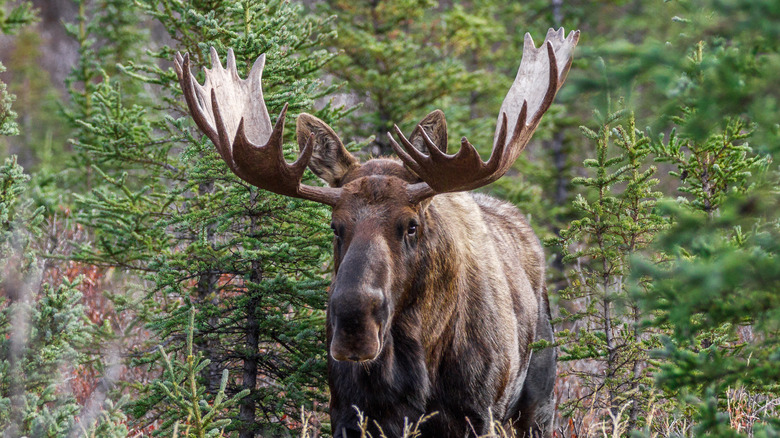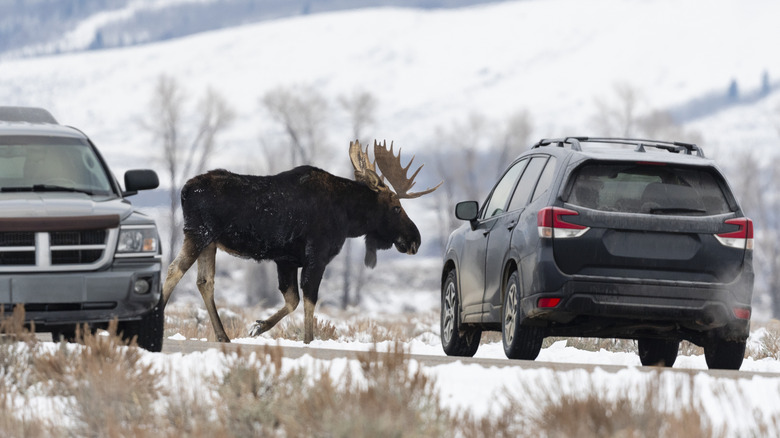The Weird Reason Canadians Were Told To Avoid Letting Moose Lick Their Car
A strange phenomenon has been happening in Canada. Wild moose have been approaching stopped cars, unprompted, in order to lick their exterior. Long revered as a symbol of the nation, these large and imposing beasts are usually timid around people and so it seems unusual for them to approach vehicles in this way, but it's become a fairly common occurrence in recent decades.
It's no secret that much of Canada gets a lot of seasonal snow and ice. In order to combat this, just about every province in the great white north uses salt on its roads and highways to de-ice the asphalt. As a side effect, much of this salt sticks to the paint, metal, and glass outside the vehicle. Unfortunately, road salt can do a lot of damage to your car, but it also turns the salty frame into a tempting target for the moose. Much like horses, deer, cattle, and other large mammals, moose need a certain amount of salt in their diets, which can be difficult for them to find in the wild. They usually get this from feeding on sodium-rich aquatic plants, but it's hard for them to pass up on what they effectively see as massive salt licks.
Several photos and videos of these giant creatures licking cars are already circulating the internet. Funny as it might be to watch a wild animal that weighs more than half a ton lick the outside of your car, Canadian park officials have asked drivers not to allow it; claiming that this behavior can lead to some dangerous unintended consequences.
Moose need to be afraid of cars
Parks officials contacted NPR in January to issue a warning that drivers shouldn't allow moose to lick their cars because, while the behavior might seem harmless in and of itself, there are serious long-term ramifications. "The animals love the taste of road salt and need salt in their diets," said Morning Edition host Steve Inskeep. "Watching this seems fun for the occupants of the car, but the interaction can cause the moose to lose their fear of cars and people, leading to traffic accidents."
This makes a lot of sense when you think about it. It's a basic tenet of animal training that positive reinforcement will cause behavior to maintain or increase in frequency. By allowing a moose to approach and lick a car, you may be inadvertently training that moose to see cars (and the people inside of them) as sources of nourishment, rather than dangerous objects to be avoided. This is bad for people as well as the animals.
According to Outdoordream.org, "Mature Canada moose bulls weigh from 1,000 to 1,400 pounds, with antlers spreading out to 60 inches." That's a lot of animal, and it presents a serious safety hazard if there is an increased risk of running into one on the road. This is such an issue that automotive brands like Volvo needed to program their self-driving cars to avoid big animals that wander into traffic. Toyota even has a special "Moose Test" that it put its Rav4 Prime through to make sure it can handle last-second evasive maneuvers to avoid collision with the creatures.
Pictures are ok, but keep it moving
So, what do you do if you're cruising along, and you see a giant moose lumber toward your vehicle? Well, you don't exactly need to slam your foot on the gas, but you also shouldn't go out of your way to pull over and let the moose get its sodium fix. Inskeep concluded the announcement by stating that, "Experts advise slowing down for a picture or two, but do not stop to let the moose snack."
This seems like a healthy compromise. It's hard to pass up the opportunity to get such a close-up photo of the usually timid and sometimes dangerous animals, but you also don't want to encourage any behavior that might attract them to cars.
There are a few things to be aware of when getting close to these creatures, however. Moose don't usually attack humans, but they are still wild animals and can be unpredictable. Males are notoriously aggressive during mating season in the fall, females may be protective of a calf in the spring, and both can react poorly when hungry, tired, or threatened. Barking dogs are also known to be a particular trigger for moose, so be sure to keep a healthy amount of space between them and your K9 companions as well.

